Introduction
The 32LG70 is currently available for about $650.
Tour & Design
Front
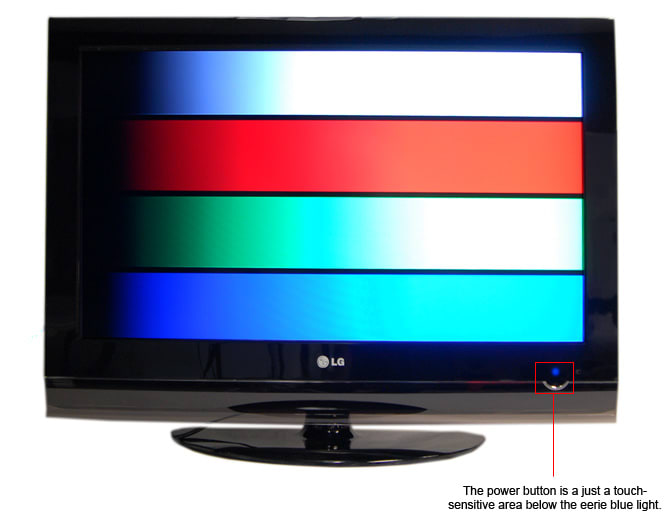
The front of the LG 32LG70 is a shiny black finish. The bezel is rather large at the bottom, and ends in a translucent tail. That glowing blue light indicates that the power is on. Frankly, we'd rather rely on whether there's an image on the screen than look at a distracting light, but what do we know? We don't design TVs, we just criticize. The power button is here, more of a touch sensitive area than a traditional button. It's sensitive enough that you might accidentally turn the TV on or off if you brush against it.
Back
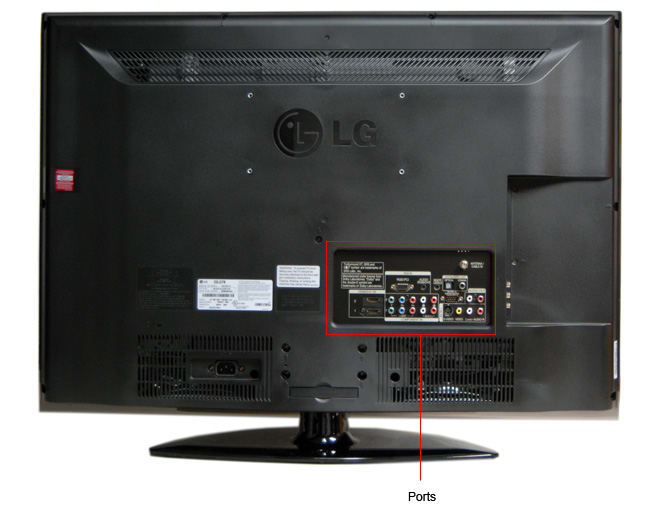
The back of a TV is something that you probably won't be looking at that much, so we can forgive ugliness. The ports are accessible thanks to the swivel base. For information about the ports on the back of the LG 32LG70 see our Connectivity section.
Sides
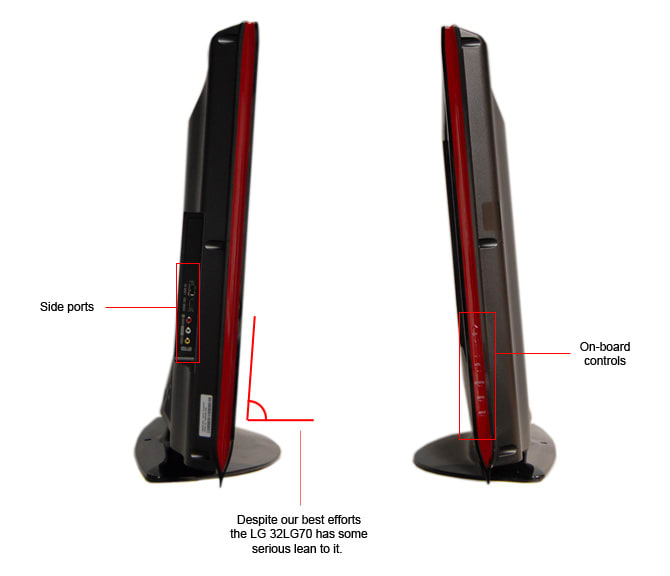
From here, you can see that the LG 32LG70 leans forward on its stand. You can also see (it's hard to ignore) the bright red trim. The TV is small enough that you needn't be concerned about it tipping over. Rather than hard, plastic button, the controls on the side are touch sensitive areas. On the other side is a modest series of ports, including the USB port for viewing photos and playing music files.
For information about the ports on the back of the LG 32LG70 see our Connectivity section.
Stand/Mount
The stand is small, but steady enough for a small 32-inch TV. It swivels just enough to gain access to the ports on the back.
Controls
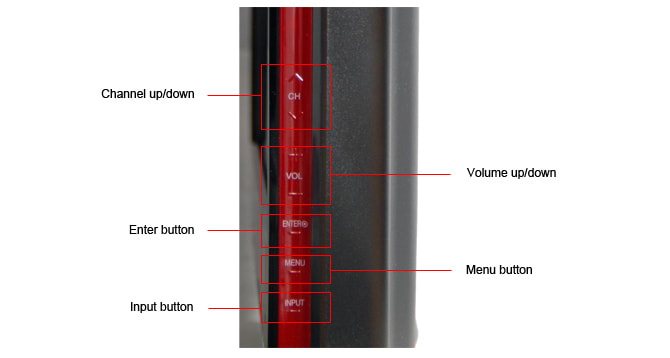
The controls are touch sensitive areas rather than buttons, and hence, lack a tactile response.
Remote Control
The remote control, while quite thin, is extremely comfortable to hold, and the buttons are all well-placed. The faux-leather finish has on oddly so-out-date-it's-back look to it, which we liked.
In The Box*(6.5)*
Very little is included in the box with the LG 32LG70: a manual, a power cord, the remote control, and batteries.
There was only minimal assembly required: insert stand into TV, screw in four screws.
Aesthetics*(4.0)*
The front of the TV looks similar to most TVs. Turn to look at the side, however, and you see the very bright red trim that runs around the edge. Do we like it? Well... it's bright and it's red. You either like the look of the Porsche/Ferrari retail stores or you don't.
Blacks & Whites
Black Level*(6.29)*
For our black level test, we set the TV to display an all black screen, then measure its luminance with our CS-200 ChromaMeter. This value is measured in candelas per square meter. Anything under 0.1 cd/m2 is great, anything around 0.2 cd/m2 is average, and our benchmark for 'not good' is over 0.3 cd/m2.
The LG 32LG70 is pretty average. An all black screen will have that 'bright black' look to it, but it isn't so bright it'll distract you while watching actual content. The main issue with an average black level is, during dark scenes, fine details will get washed out. We think the 32LG70 will be fine for a mainstream audience, but those with discerning eyes should look elsewhere.
Peak Brightness*(8.85)*
On our peak brightness test, we set the TV to display an all white screen, then again employ our CS-200 ChromaMeter to measure the screen's luminance. Dull whites result in a loss of detail in bright scenes, or in bright areas.
We didn't have any issues with the 32LG70 on this test. We measured its peak brightness at 349.63 cd/m2, which is very bright. External lights shoulnd't wash out displayed content, and bright areas should look sufficiently bright.
Contrast*(6.80)*
Contrast refers to the ratio of the deepest blacks to the brightest whites. Since our vision is based on detecting contrast, this ratio is an important specification on a TV. Unfortuantely, lots of manufacturers pad their own measured ratios to make them seem much more impressive. One common trick is to measure the black level when the backlight is off, then change the settings to boost brightness before measuring the peak white. Since both measurements use different settings, the resulting contrast ratio isn't possible during normal viewing.
We measured the TV's contrast ratio at 1589:1, which is decent, but not great. The TV's shallow black level is what really hurt it here. Again, while this should suffice for the average viewer, it won't satisfy a picture quality enthusiast.
Tunnel Contrast*(9.96)*
This test aims to catch TVs that cheat and lower black levels when the majority of the screen is dark. While this results in a deeper black, it comes at the expense of detailing in brighter areas and doesn't add any additional detailing in the darker ones.
Fortunately, the 32LG70 doesn't resort to such underhanded methods of spec boosting. We commend the LG 32LG70 for its honesty, and have awarded it lots of points.
White Falloff*(9.83)*
The white falloff test is the same as the test above, only it measures the peak brightness instead of the black level. Plasmas are terrible at this test, since they can't draw enough power to maintain a solid brightness over large areas of the screen.
The 32LG70 performed admirably at this test, by having a very solid peak brightness level regardless of the percentage of white on the screen.
Uniformity*(8.0)*
This score hinges on the presence of blotches on the screen, or other manufacturing abnormalities that can affect picture quality. We didn't see much wrong with the 32LG70 other than some minor, common issues.
Greyscale Gamma*(7.64)*
Greyscale gamma describes how the TV scales its greys to white and black. Since we 'see' logarythmically, there should be very minute luminance differences towards the black end of the spectrum and very large differences towards the white end. If the TV doesn't have the proper greyscale gamma, fine details will become harder for our eyes to register. When the TV's greyscale is plotted logarythmically, it should result in a straight line with a slope between 2.1 and 2.2. There is a bit of wiggle room here, but typically anything below 2.0 or above 3.0 is less than ideal.
The LG 32LG70 did well on this test, with a measured gamma of 2.59. This is a bit high, but well within acceptible limits. As you can see below, the line is relatively smooth, with only minor bumps. These bumps represent lost detail due to a lack of differentiation between adjacent shades.
Resolution Scaling*(7.88)*
Your HDTV use will likely not be limited to the TV's native resolution. Standard definition content is in 480p, DVDs play at 720p, streaming HD content is 1080i, and Blu-rays are run 1080p. Since we're awesome and thorough, we test all the non-native resolutions your HDTV could feasibly display.
480p*(8.65)*
We didn't see any issues with 480p content. We couldn't get images to be as sharp as we'd like, however, without ugly artifacting. Also, some fine patterns had a faint shimmer effect to them. Otherwise, the 32LG70 performed well on this test.
720p*(8.5)*
Like our 480p runthrough, we didn't find any issues worth harping on with 720p playback. The sharpness issues are slightly worse here, though, as the different elements of fine patterns tend to blur together.
1080i*(6.50)*
The 32LG70 took a bit of a nose dive with 1080i playback. We saw a lot of false coloration in fine patterns, where a series of black and white stripes would somehow acquire a pale green hue. The individual elements of these patterns were sometimes utterly blurred out, so the pattern itself looked like a solid block of grey (or greyish pale green).
Color Accuracy
Color Temperature*(9.98)*
When we calibrate our TVs, we try to get the color temperature as close to the ideal 6500K as we can. Unfortunately, calibration can only get you so far. Typically color temperature will shift around slightly throughout the greyscale. If the TV is good, these shifts won't be perceptible, or, if they are, those shifts will be so small and brief they won't realistically be noticed. You start running into issues when these shifts are very noticible, or extend over a long span of the greyscale.
Fortunately, the LG 32LG70 had a solid color temperature. The only shift that's remotely perceptible is towards the black end of the spectrum, where the temperature drops just barely low enough to technically classify as 'warm.' This blip won't be noticeable during normal use.
RGB Curves*(7.73)*
Thanks to the physics of light, every color on your TV can be constructed from some combination of red, green, and blue. Since these three colors are so important, we test them separately. We feed the TV varying intensities of each, then record what's being displayed. Ideally, these points of data should construct a smooth curve. Any 'stair-stepping'in the line represents an area of lost detail, since the TV is essentially displaying the same shade of a color for two different intensities.
In the graph below, you'll see a lot of stairstepping. The curves themselves look bumpy, meaning an uneven progression of black to high-intensity color. Although the red channel was a bit slower to intensify than the green and blue channels, it showed far less peaking. Note how, towards the higher intensities, green's curve plateaus considerably and blue outright flattens.
Below you'll find a few strips of color, which represent the red, green, and blue performances of the 32LG70. We've paired these results up against the ideal response and the results from a few competing models.
Color Gamut*(4.73)*
The range of colors a TV displays are set by an international standard, called rec. 709. This standard dictates the red, blue, green, and white points all TVs should be displaying. We take our own measurements of the TV's performance and compare them up to rec. 709 to see how well they adhere to the standard.
The LG 32LG70 follows the standard fairly well, by having near-perfect white and red points. The green point is skewed a bit towards blue, however, and the blue point is oversaturated and pushed towards red.
Below is a table of our measurements and the rec. 709 coordinates.
Motion
Motion Smoothness*(6.0)*
The LG 32LG70 didn't have any significant issues with motion blur, regardless of whether the TV was playing back 1080p or 1080i content. We noticed photos got slightly blurry, but weren't too bad. The eyes blurred into ovals, the finer details of the nose were lost, and the mouth looked cartoonish. Solid blocks of color would trail shadows behind them as they moved across a grey background. Fine patterns lost a lot of contrast between their individual elements.
While the TV had problems, they weren't particularly bad.
Motion Artifacting*(6.13)*
The TV did have some trouble with artifacting, specifically with fine patterns, and more so with 1080i than 1080p content. The main issue here was shudder, which we saw in all our individual artifacting tests. The reason fine patters were so bad is because the shudder created a bit of a flashing effect, which can be distracting. We also saw false colration in black-and-white patterns: as the pattern moved, it created a rainbow stripe just behind its leading edge.
3:2 Pulldown & 24fps*(8.0)*
The TV did well on our two 3:2 pulldown tests. One uses a SMPTE pattern, which is where we saw the biggest issue: fine patterns would flash slightly as they moved around the screen. Other than that, the TV did well on this part. The second part is a slow pan over an empty stadium. Here we saw a crawling effect over the backs of the empty seats that turned into vertical shudder as the camera approached a perpendicular angle.
Viewing Effects
Viewing Angle*(3.56)*
For our viewing angle test, we measure how the TV's contrast changes as you move around the TV. Due to their different display technologies, LCDs typically do poorly on this test and plasmas do well. The benchmark we use is the angle at which the TV's total contrast ratio drops by 50%.
The LG 32LG70 had a very, very poor viewing angle, even for an LCD. We measured the 50% contrast point at 12° away from center, for a total viewing angle of about 24°. This is a bit under our current average of 30°.
Basically, you aren't going to get a great viewing angle out of an LCD. If this is an important feature for you, consider plasmas.
Reflectance*(6.0)*
The LG 32LG70 tries to diffuse external light, as opposed to reflecting it. Unfortunately, the diffue effect isn't great and the TV still ends up reflecting a bit. When we shined an LED array at the screen, we were able to count all the LEDs in the array. Surrounding this reflection was a large diffuse glow with a faint cross pattern streaking away. Although this glow is very distracting during dark scenes, it wasn't terrible during moderate-to-bright ones. Also, when the light is shining on the TV from off-center, it shouldn't be much of an annoyance. The glow will be significantly minimized, and there will only be a slight reflection on the bezel.
Video Processing*(1.5)*
The 32LG70 does have a few video processing features, but we weren't particularly impressed by them. Their effects were minimal, or had unwanted side effects.
Calibration
Calibration
To ensure we're testing each TV at its best, we first run it through our calibration process. This procedure uses a CS-200 ChromaMeter and DisplayMate, which is software specifically designed for testing display technology.
[
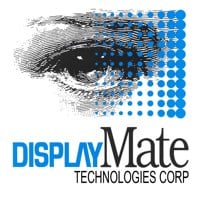
](http://www.displaymate.com/)The 32LG70 actually doesn't require much calibration out of the box. Just select Expert mode and tweak the brightness and contrast slightly and you're good to go.
Video Modes
The LG 47LH90 has a few video modes available, but doesn't offer up specific descriptions for any of them. You can set the TV to Vivid, Standard, Natural, Cinema, Sport, or Game. There's also two Expert modes, which allow you to customize your own settings.
Remote Control

Ergonomics & Durability*(5.6)*
The remote control for the LG 32LG70 is not necessarily impressive at first glance, but it's surprisingly comfortable and well designed. The remote is thinner than most, and weighs less. Frequently, TV remotes have a deep groove underneath that hugs your finger and screams, 'Look! I am ergonomic!' This remote has two (!) such grooves on the bottom, but it doesn't even need them. It's so light and well-balanced, there's no need to force the fit into your hand.
As for durability, that's a question only time can truly tell. As a quick stress test, we tried to snap it in half (gently), and the plastic didn't even creak. That's a good sign, in our opinion.
Button Layout & Use*(6.2)*
The button layout is smart, with most of the important functions within reach. Channel up/down, volume up/down, and the 0-9 numbers are probably the most frequently used buttons, and are all grouped together. If you want to use the menu and TV functions (i.e., changing the input or picture settings) you need to choke up on the remote, where these buttons are in another little group. That's smart, considering you're likelihood of performing one set of tasks, or another, but rarely both at the same time.
Programming & Flexibility*(1.0)*
The remote is not programmable, in the strict sense of the word. If you have other LG products that offer the 'SimpLink' feature, this remote can run double-duty for basic play/stop/rewind/fast forward functionality.
Connectivity
Input Ports*(7.0)*
The LG 32LG70 has the basic array of ports, plus a few extras. Input ports on the rear of the TV include: 2 HDMI ports, a PC-input with a corresponding 1/8th-inch audio jack, an antenna/cable jack, 2 component ports, 1 composite port, 1 S-Video port, and three analog audio ports.

On the side of the TV, there's 1 composite video input, 1 analog audio input, and another HDMI.

Output Ports*(3.0)*
There are three audio output ports, one analog and two digital. The two digital ports are a TOSLINK and a coax.
Other Connections*(0.0)*
There are no network connections on the TV.
Media*(1.0)*
The USB port on the side of the LG 32LG70 is capable of playing photos and music, but not video clips.
Placement*(0.0)*
The port placement is fine because of the swivel base.
Audio & Menus
Audio Quality*(5.0)*
The 32LG70's speakers weren't bad once surround sound mode is turned on. When it's off, there's no depth to the sound at all and when it's on it sounds like normal stereo. The TV had a really weak, muddy bass response. The TV did have a decent mid-range and high-end response, however.
Menu Interface*(7.0)*
The 32LG70's menu system is fairly intuitive. Pressing the menu button will let you chose from one of eight different items. Selecting one will bring up a second screen, where the eight main items run down the left side and the selected menu is expanded to the right.
The menu system is very basic, but we really don't like the initial screen. Since you can tab through the main menu items in the second screen, there's really no functional benefit to the first screen other than to familiarize you with the icons. If the second menu screen had been larger and contained labels, they could have eliminated an otherwise superfluous round of navigation.
There's also a quick menu. This is presented like a rotary dial: left and right rotate the wheel of menu items, and up/down alter its settings. This is tehcnically quicker for changing certain items, but the rotation animation slows the process down a bit.
Manual*(4.5)*
The 32LG70's manual really isn't great. The only thing it does well is pictures, which are very detailed and employed frequently, if they are a bit small. The table of contents is very limited, there isn't an index (although there is a brief appendix), and the pages aren't tabbed. The font size is a bit on the small side as well.
The main complaint we had, however, is it really doesn't answer a lot of questions. The manual is really only good for setting up the TV, not explaining how to use its features. We aren't entirely sure what features like Eye Care and Edge Enhancer actually do.
You can find the LG 32LG70's manual online here.
Formats & Media
Formats*(10.0)*
The LG 32LG70 is a 1080p HDTV. That means it also supports 480p, 720p, and 1080i playback. It also supports 3:2 pulldown and 24p content.
Photo Playback*(3.50)*
The LG 32LG70 supports photo playback from a connected USB device. The interface involves a file browser view with the option for fullscreen view. There is no slideshow option, so you'll need to move between photos with the remote. You can have music from the USB drive play in the background.
Music & Video Playback*(2.50)*
The 32LG70 can also play back MP3 files. The interface is similar to the one described above, with a file browser view and separate screen for playback. It's a bare-bones implementation of the feature, but it gets the job done.
Streaming Playback*(0.0)*
The 32LG70 can't stream content.
Other Media*(0.0)*
There are no other media options available on the 32LG70.
Power Consumption
Power Consumption*(9.07)*
Televisions require power to run, which ups your electricity bills. The yearly cost for your HDTV probably won't be significant, but it will cost you. To find out how much you'll end up spending per year, we measure each TV's average wattage, then assume average usage.
The 32LG70 doesn't cost much to run per year. Even if you're blasting the backlight, you'll be spending about $26 per year. Granted, it's a 32-inch set, which obviously draws less power than a larger screen, but this is still a very low cost per year .
Below we've compared the 32LG70 to a few competing TVs.
Vs Samsung LN32B460
Value Comparison Summary
Both the LG and Samsung are at the same price point and size. The LG is a 1080p HDTV, while the Samsung's native resolution is 720p. The Samsung has a much deeper black level and higher overall contrast ratio. It also performs slightly better than the LG on other tests. Unless you're really sold on the native resolution, the Samsung looks to be the better TV.
Blacks & Whites
The Samsung has a much deeper black level and a negligibly higher peak brightness. It has a significantly higher contrast ratio.
Color Accuracy
Neither TV has a color temperature worth worrying about, although the LG is more solid than the Samsung. The Samsung has slightly better color representation, however. Both TVs slightly oversaturate green. The LG has a good red point and slightly oversaturated blue, while the Samsung has a more accurate blue and less accurate red.
Motion
The LG handles motion slightly better than the Samsung, but has slightly more artifacting.
Viewing Effects
The LG has a terrible viewing angle, but the Samsung isn't exactly stellar.
Connectivity
The LG has an extra digital audio out option and a USB port. Although it's not the greatest selling point, the LG can use its USB port to play back photos and music.
Vs JVC LT32P679
Value Comparison Summary
The LG and JVC seemed to go back and forth in our testing. The JVC had better performance on our blacks-and-whites tests, but the LG had a much more solid color temperature. The LG costs slightly more, but offers a native resolution of 1080p, while the JVC's native resolution is only 720p.
Blacks & Whites
The JVC is capable of a deeper black, but isn't as bright. It has a better contrast ratio, but it didn't exactly blow the LG out of the water.
Color Accuracy
The LG has a much more even color temperature compared to the JVC, which is incredible cool-looking towards the dark end of the greyscale. While LG has incrimentally better color representation, the JVC's color gamut is more accurate.
Motion
The JVC has much less artifacting than the LG, but has slightly more motion blur.
Viewing Effects
The JVC has a slightly larger viewing angle than the LG, but it wasn't very wide either.
Connectivity
The LG has a few more ports, which include an extra digital audio output and a USB port. The USB port allows the LG to play back photos and music. This isn't groundbreaking, but it is a nice feature to have in a pinch.
**
**
Vs Vizio VO320E
Value Comparison Summary
The biggest difference between the LG and the Vizio is native resolution: the LG runs at 1080p, while the Vizio uses 720p. The Vizio manages to be cheaper, but the LG outperformed it on most of our tests.
Blacks & Whites
The LG has deeper blacks and bright whites, which equate to a higher overall contrast ratio.
Color Accuracy
The LG has a much better color temperature; the Vizio runs noticibly cool throughout most of the spectrum. Both TVs have similar color representation, although the Vizio has the more accurate color gamut.
Motion
The Vizio has some severe issues with blurring and artifacting.
Viewing Effects
The Vizio has an average viewing angle for an LCD. The LG is below average is this regard. Neither are even remotely close to a plasma's performance.
Connectivity
The LG has an extra HDMI port and a second digital audio out. There's also a USB port for music and photo playback.
Conclusion
Series Comparison
xxLG70 Series
The xxLG70 is a small series of televisions, with only three models. All share the bright red trim running around the outer-edge of the body and a handful of features.
Meet the tester
Mark Brezinski works on the Home Team, reviewing refrigerators, minifridges, dishwashers, washing machines, dryers, air conditioners, air purifiers, and fans.
Checking our work.
Our team is here to help you buy the best stuff and love what you own. Our writers, editors, and experts obsess over the products we cover to make sure you're confident and satisfied. Have a different opinion about something we recommend? Email us and we'll compare notes.
Shoot us an email